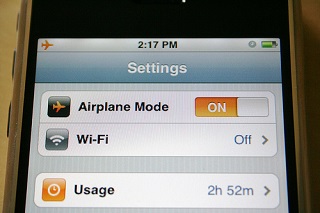
What happens when you don’t put your phone on airplane mode on an airplane?
Airplane mode disables a device’s cellular radio, Wi-Fi, and Bluetooth — the wireless transmission functions. But many airplanes now offer in-flight Wi-Fi, and cellular access may be coming to planes soon — so where does that leave airplane mode?
Even if you never fly, airplane mode offers a quick way to disable your device’s battery-draining radios. It can extend your device’s battery life as long as you don’t need any of those wireless radios.
What Does Airplane Mode Do?
Yes, You Can Use Electronics During Takeoff and Landing: What You Need to Know
Regulatory agencies in the US, Canada, and Europe now allow you to use electronics during takeoff and landing. This is…
Whatever device you’re using — an Android phone, iPhone, iPad, Windows 8 tablet, or whatever else — airplane mode disables the same hardware functions each device. This includes:
Cellular: Your device will stop communicating with cell towers. You won’t be able to send or receive anything that depends on cellular data, from voice calls and SMS messages to mobile data.
Wi-Fi: Your phone will stop scanning for nearby Wi-Fi networks and attempting to join them. If you’re already connected to a Wi-Fi network, you’ll be disconnected.
Bluetooth: Airplane mode also disables Bluetooth, a wireless communication technology most people associate with wireless headsets. But Bluetooth can be used for many other things, including keyboards and mice.
GPS: Airplane mode also disables GPS-receiving functions, but only on some devices. This is a bit confusing and inconsistent. In theory, GPS is unlike all the other technologies here — a device with GPS turned on is only listening to GPS signals it receives, not transmitting any signals. However, some aircraft regulations do not allow the use of GPS-receiving functions for some reason.
When airplane mode is enabled, you’ll often see an airplane icon in your device’s notification bar — this appears on the top bar on Android devices, iPhones, and iPads. You can still use devices on the aircraft — even during takeoff and landing — as long as airplane mode is enabled. You don’t have to power them off.
Why is Airplane Mode Necessary?
Regulations in many countries prohibit the use of devices that transmit signals on commercial aircraft. A typical phone or cellular-enabled tablet is communicating with several cell towers and attempting to maintain a connection at all times. If the towers are far away, the phone or tablet has to boost its signal so it can communicate with the towers. This sort of communication could interfere with an airplane’s sensors and potentially cause issues with sensitive navigation equipment. That’s a concern that brought these laws about, anyway. In reality, modern equipment is robust. Even if this does cause problems, your plane won’t fall out of the sky because a few people forgot to enable airplane mode!
A more demonstrable concern is that, as you’re traveling very quickly, all the phones on the plane would be constantly handing off from cell tower to cell tower. This would interfere with the cellular signals people on the ground receive. You wouldn’t want your phone to do this hard work, anyway — it would drain its battery and it wouldn’t be able to maintain a signal properly, anyway.
Battery Saving
Airplane mode can help even when you’re on the ground. It’s an excellent way to save battery power on your device. The radios on a device use a large amount of power, communicating with cell towers, scanning for nearby Wi-Fi networks and attempting to connect, waiting for incoming Bluetooth connections, and occasionally checking your location via GPS.
Turn airplane mode on and all the radios will be disabled. Bear in mind that this will block incoming phone calls and SMS messages on a phone, but it can be a great battery-saving tip if you really need that last bit of juice. It’s especially useful on a tablet when you’re just using your tablet as an offline eReader anyway.
Wi-Fi and Bluetooth Can Be Enabled in Airplane Mode
Wi-Fi is allowed on some airplanes — in fact, many airplanes now offer in-flight Wi-Fi you can pay for. Enabling airplane mode always disables Wi-Fi. However, on most devices, you can enable Wi-Fi after enabling airplane mode. Cellular signals will still be blocked, but Wi-Fi will be working so you can connect to that in-flight Wi-Fi network.
Some devices also allow you to enable Bluetooth when airplane mode is enabled. Whether this is allowed depends on your airline and the regulatory agency is in charge.
Cellular Signals on Airplanes: Coming Soon?
Cellular signals may be coming soon to airplanes, too. The US FCC is potentially looking at changing rules to allow cellular signals on planes above 10,000 feet. This is usually explained in the media as “allowing cell phone calls on planes,” but it’s more than that — it would also allow texting and any service that uses cellular data. In fact, the US DOT is considering banning cell phone calls on planes. The end result is that you’d be able to text and use cellular data on a plane, but not have voice phone calls — that would be extremely obnoxious to the people near you.
You wouldn’t normally be able to connect to cell towers on the ground, but an airplane that allowed cellular radios would be equipped with “picocells.” These are small cellular base stations the phones in the plane would connect to. The phones connect to the picocell like they would any other cell tower. The picocell beams their signal to a communications satellite, which beams the signal back to a base station on the ground where it connects to Earth’s cellular network.
Because the transmitter on the plane is so close to the phones on the plane, the devices can communicate at their lowest transmitting power level. Phones on the plane won’t boost their signal and attempt to contact cell towers on the ground, so this “eliminates the potential for interference,
Even if cellular signals were allowed on airplanes, and even if every airplane on Earth were equipped with a picocell, airplane mode would still be necessary. Airplanes that allow WI-Fi do so only above 10,000 feet, and the US FCC’s proposed regulations would only allow cellular signals above 10,000 feet. Airplane mode would still be necessary during takeoff and landing — or just if you wanted to get some shut-eye and save your phone’s precious battery life.








